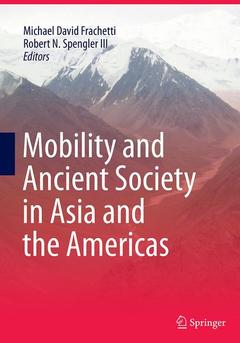Description
Mobility and Ancient Society in Asia and the Americas, Softcover reprint of the original 1st ed. 2015
Coordinators: Frachetti Michael David, Spengler III Robert N.
Language: English
Subjects for Mobility and Ancient Society in Asia and the Americas:
Publication date: 10-2016
Support: Print on demand
Publication date: 08-2015
202 p. · 17.8x25.4 cm · Hardback
Description
/li>Contents
/li>Biography
/li>Comment
/li>
Mobility and Ancient Society in Asia and the Americas contains contributions by leading international scholars concerning the character, timing, and geography of regional migrations that led to the dispersal of human societies from Inner and northeast Asia to the New World in the Upper Pleistocene (ca. 20,000-15,000 years ago). This volume bridges scholarly traditions from Europe, Central Asia, and North and South America, bringing different perspectives into a common view. The book presents an international overview of an ongoing discussion that is relevant to the ancient history of both Eurasia and the Americas. The content of the chapters provides both geographic and conceptual coverage of main currents in contemporary scholarly research, including case studies from Inner Asia (Kazakhstan), southwest Siberia, northeast Siberia, and North and South America. The chapters consider the trajectories, ecology, and social dynamics of ancient mobility, communication, and adaptation in both Eurasia and the Americas, using diverse methodologies of data recovery ranging from archaeology, historical linguistics, ancient DNA, human osteology, and palaeoenvironmental reconstruction. Although methodologically diverse, the chapters are each broadly synthetic in nature and present current scholarly views of when, and in which ways, societies from northeast Asia ultimately spread eastward (and southward) into North and South America, and how we might reconstruct the cultures and adaptations related to Paleolithic groups. Ultimately, this book provides a unique synthetic perspective that bridges Asia and the Americas and brings the ancient evidence from both sides of the Bering Strait into common focus.
Chapter 1: Introduction Michael D Frachetti and Robert N. Spengler III.- Chapter 2: Nomadic Mobility, Migration, and Environmental Pressure in Eurasian Prehistory Michael D. Frachetti.- Chapter 3: Early Human Expansion into Kazakhstan and Subsequent Paleolithic Migrations Zh. K. Taimagambetov.- Chapter 4: Tracing Human Movements from Siberia to the Americas: Insights from Genetic Studies Theodore Schurr.- Chapter 5: Stemmed Points, the Coastal Migration Theory, and the Peopling of the Americas Jon M. Erlandson and Todd J. Braje.- Chapter 6: The Initial Colonization of North America: Sea-Level Change, Shoreline Movement, and Great Migrations David G. Anderson and Thaddeus G. Bissett.- Chapter 7: Early Asiatic Migration to the Americas: A View from South America Gustavo Politis, Luciano Prates and S. Ivan Perez.- Chapter 8: Cranial Morphology of Early South Americans: Implications for Understanding Human Dispersion into the New World Mark Hubbe, Walter Neves and Katerina Harvati.- Chapter 9: How America was Colonized: Linguistic Evidence Johanna Nichols.- Chapter 10: Kinship, Demography, and Paleoindian Modes of Colonization: Some Western Canadian Perspectives John W. Ives.- Chapter 11: The Problem of Settlement of the American Continent: Old and New Objectives and Approaches Galina Ershova.- Chapter 12: Late Pleistocene Colonization of North America from Northeast Asia: New Insights from Large-scale Paleogeographic Reconstructions James E. Dixon.- Chapter 13: The Third Wave: The Results of the First International Meeting on Great Migrations and the Bronze Age Expansion out of Southern Arabia Olzhas Suleimenov.
Dr. Michael Frachetti is a professor at Washington University in St. Louis. The main focus of his research is on the dynamic strategies of pastoral nomadic societies living in the steppe region, mountains, and deserts of Central and Eastern Eurasia. His work centers primarily on pastoralism in the Bronze Age, which is intricately tied to questions of social and economic interaction between regional populations across Central Asia at that time. His theoretical interests center on how social groups utilize economic and political strategies to communicate inter-regionally, and how variability in their economic and social strategies introduces opportunities for reshaping the boundaries of their social landscapes and human interactions. He is also interested in the relationships between pastoral strategies and the environment, and how the choices and ways of life of mobile groups contributed to the formation of wide reaching networks as early as 2000 BC (the Mid-Bronze Age). He currently conduct field research in Eastern Kazakhstan, where He is exploring the ways by which pastoral societies employed flexible temporal and spatial patterns of mobility to negotiate ecological constraints as well as alter the political and social conditions of their landscape.
Dr. Robert N. Spengler III is a research associate at Washington University in St. Louis. He is using macrobotanical methods to the study of prehistoric Inner Asian economy, specifically looking at trajectories of agricultural spread and adoption. He is interested in questions about the paleoenvironment, cultural exchange, and social orders in the arid and mountainouszones of Central Asia and western China. These questions feed into a broader understanding of human adaptations, social development, and complexity, while building a new view of the development of complex societies and the role of agricultural intensification.
Provides a global overview on the issue of early migrations in archaeology
Highlights a unique synthetic perspective that bridges Asia and America and brings the ancient evidence from both sides of the Bering Straights into common focus
Contains proceedings by leading international scholars Includes case studies from Inner Asia (Kazakhstan), Southwest Siberia, Northeast Siberia, and North and South America
Includes supplementary material: sn.pub/extras




